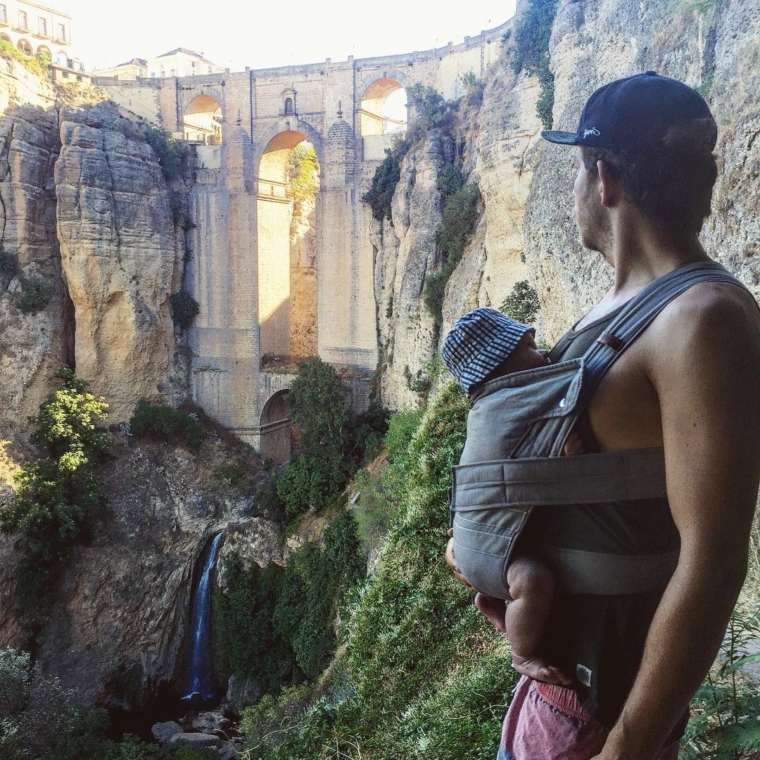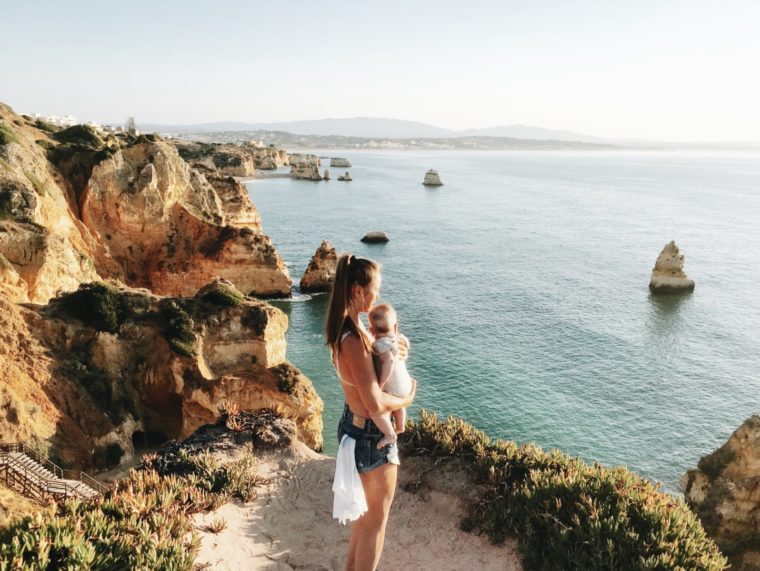10 Travel with baby basics
While we travel with baby we need to adapt several daily basics to our current circumstances. These are our 10 travel basics:
1. Sleep
Our little nomad is now sleeping in the carrycot of our stroller, that we put next to our bed. For cooler nights we have a baby sleeping bag. For warmer nights she only wears a romper.
As soon as she will not fit in there any more, we will get a sleeping tent, such as this one:
2. Eat
If you are breastfeeding and your baby is not yet 6 months old, you don’t need to adapt anything. Unfortunately, I was not able to breastfeed and we therefore prepare infant formula. Most apartments are equipped with a water boiler, so you don’t need to take one with you. Or, in case there is none, you cook the water in a pot. If it’s hot, you may just take the water from the water bottle (the label should say it’s appropriate for baby food).
If you use formula, you should consider that even if a country sells your brand, it may not have exact same ingredients. Every country has its own standards and the manufacturer therefore adapt their compounding. You have two possibilities: order online your formula e.g. with Amazon to your current location, or switch to a divergent formula available at your destination. We are currently ordering formula online, as we can store it in the car.
There is one gadget we needed to take with us: a vaporiser to disinfect the bottles. Nevertheless, there is a small travel with baby version for 2 bottles at a time (we took 4 bottles with us).
3. Poop
Back home you probably have a diaper changing table. However, if you travel with baby, you need to be more flexible. So far we used dining tables, desks, drawers. It all really works well! If we need to change diapers while being on the way, the stroller is very convenient to change diapers. Alternatively, the car’s back seat works, too. Or, worst case (if you only took the carrier) on the table in a cafe. If it’s empty and the waiter is nice, it’s not a problem 😉
Oh, and you might want to take either a disposable swimming diapers or a washable one with you.
4. Sunscreen
Dermatologists always recommend: first, cover the body of your baby; second, don’t expose it to direct sunlight. Even in shade you need to use sunscreen for the remaining parts, such as hands or face. If it’s so hot that you don’t want your baby to wear long sleeves, use SPF 50 sunscreen. In this case buy one that does not contain Octocrylene, as it has hormonal effects in cell cultures. This one for instance does not contain Octocrylene:
Alternatively, there are sunscreens that don’t affect the skin of your baby. They work only with physical filters, which means that they also stay on the skin. As an example: Daylong Baby Sunscreen. In both ways, I have to admit it’s not ideal.
5. Baby clothes
We only took clothes with us that fitted our baby girl at the time. As soon as she was growing, we bought new ones on the way. We usually have 6 short rompers and 2 long ones. Additionally, we have 1 hat. A swim shirt for a 1-4 month-old is not really necessary as you hardly go for a “swim” with your baby. We only have been in a pool with her once and a few times in the sea. Especially with waves it’s not so easy.
6. Bathing
Of course we didn’t take a baby bath tub. If you travel wth baby you may bath your baby either in the sink, under the shower or in the bathtub. While one is holding her and the other does the cleaning.
7. Medical checkups
It might sound unbelievable: there are babies in other countries, too 😉 Therefore, you can visit local paediatricians to do the routine checkups while you travel with baby. We had one checkup at a paediatrician’s practice in Spain. We did the appointment 1 week in advance. The physician was very nice and took all the time that was necessary. Surprisingly, we only paid 60 € at the end.
Furthermore, we needed to get 3 follow-up vaccinations. In order to do that, we got a referral to a medical center. We needed to buy 1 of the 3 vaccinations in a pharmacy in advance. The other ones were directly available at the medical centre. The total cost for this procedure was even more surprising: 0 €!
Back in Germany we spoke to 2 physicians regarding our trip. One of both said that it’s a great idea and the other one was not happy at all. However, both Spanish physicians were not a bit concerned that we are travelling with a 3-month old.
An article on baby vaccines is now available here.
8. First-aid kit
Although you can get almost anything at local pharmacies while you travel with baby, you might want to take a first-aid kit with you. Usually, if any particular medicine is not available, it often only takes one day to deliver. However, natural medication is often not available on the spot.
Find out more about a first-aid kit for travel here.
9. Stroller versus Carrier
Stroller versus Carrier is actually a question of how you want to travel with baby. A stroller has definitely a lot of advantages. As previously mentioned, we use it as bed and diaper changing table. If your baby is not able to sit yet, it is very convenient to use a stroller/pram if you’re in a restaurant or a cafe. Plus, it carries all your stuff. If it is very warm it is also much nicer to use the stroller. BUT it needs a lot of space and many countries do not have appropriate pavements. Therefore, I suggest to take both, a stroller and a baby carrier if you travel by car most of your route. If you fly and have no car at your destination, only a carrier. Or, additionally, a light buggy if your baby is able to sit.
As a matter of convenience, we decided to travel by car since our baby was 7 weeks old.
We chose Cybex Priam as a stroller for the following reasons:
- Clean design 🙂
- You can adjust the sun cover lower than on other strollers
- You can jog with it on a plain ground (lockable front tires)
- The tires are filled with air for more comfort
- Off-road tires are available
- Easy to reassemble
- Not too big, not too heavy
10. Baby car seat OR no car seat OR a car seat alternative?
If you plan to travel longterm you want to be a minimalist. Leave your stroller home, only one bag for all! But what to do with the bulky car seat? Having a car accident is a calculable risk. E.g. in the US 30,800 fatal motor vehicle crashes happened in 2012. Unfortunately, there is no “light” alternative for a baby car seat (I did the research). Therefore, you need to decide whether you want to expose your baby to that risk. This is not about panicking, I just want to decide consciously. You might argue that they even drive on scooters with the whole family in Thailand. This is absolutely true but a lot more die (26,000) from road accidents there. Of course you also swim in the ocean although you might be attacked by a shark. So ask yourself: is it worth to take the risk or not?
If you are flying and mostly use trains / busses at your destination and a few times a taxi, the risk is much smaller and a car seat might not be necessary. Also, driving with a Tuc Tuc a few time is probably fine. As we are now on a road trip by car we took a car seat with us. In the past 2 weeks our baby started to get annoyed of sitting too long in the car seat. Sometimes it’s not possible to dive by, so I took her out a couple of times. Here, it was ‘worth the risk’.
More to read

